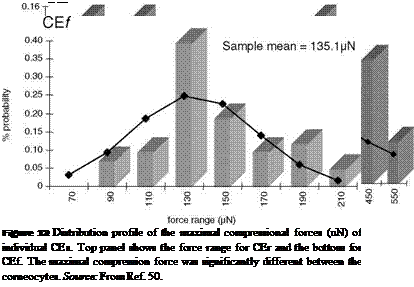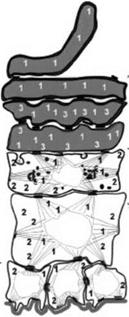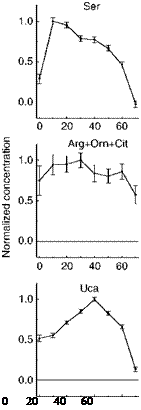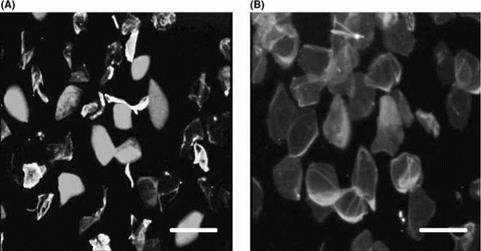A historical perspective on filaggrin biology was given by Rawlings et al. (1). Biologically, NMF allows the outermost layers of the SC to retain moisture against the
|
Figure 11 Double staining of CEs with Nile red and anti-involucrin (shown here in gray scale). (A) Face and (B) upper arm. Source: From Ref. 51. |

desiccating action of the environment. Traditionally, it was believed that this water plasticized the SC, keeping it resilient by preventing cracking and flaking which might occur due to mechanical stresses. The general mechanisms by which these NMF components influence SC functionality have been studied extensively. From a physical chemistry perspective, the specific ionic interaction between keratin and NMF, accompanied by a decreased mobility of water, leads to a reduction of intermolecular forces between the keratin fibers and increased elastic behavior. Recent studies have emphasized that it is the neutral and basic free amino acids (53), in particular, that are important for the plasticization properties of the SC. The generation of NMF is summarized by Mechin et al. (Fig. 13) (54) which also highlights the importance of peptidylarginine deminases involved in the processing of filaggrin and thereby allowing its hydrolysis to NMF.
Recently, hyaluronic acid has been shown to be present naturally in the SC (55) as has glycerol. Glycerol will also be derived from sebaceous triglyceride breakdown and
again, to emphasize the importance of this molecule, studies by Fluhr et al. (56) have indicated that topically-applied glycerol can completely restore the poor quality of SC observed in asebic mice (that are lacking sebaceous secretions) to normal. The importance of glycerol as a natural skin moisturizing molecule has also been shown by Elias et al. (57) However, typically, these two molecules have been largely ignored in descriptions of NMF composition (1). Recent data also indicates that lactate plays a critical role in influencing the physical properties of the SC. Lactate and potassium were found to be the only components of the NMF analyzed that correlated significantly with the state of hydration, stiffness, and pH in the SC (58).
The generation and maintenance of an acid pH within the SC, the so-called “acid mantle,” is critical to the correct functioning of this tissue. Studies point to an essential role of free fatty acids generated through phospholipase activity as being vital for SC acidification (59), while Krein and Kermici (60) have recently proposed that urocanic acid plays a vital role in the regulation of SC pH. Although this is in dispute, it is likely that all NMF components contribute significantly to the overall maintenance of pH.
Other components of NMF are also not derived from filaggrin, and urea, like lactate, may also be derived in part from sweat. However, the presence of sugars in the SC represents primarily the activity of the enzyme beta-D-glucocerebrosidase, as it catalyzes the removal of glucose from glucosylceramides to initiate lipid lamellae organization in the deep SC (1).
New measurement tools have been developed in the last decade for the measurement of such compounds in vivo. Caspers et al. (61) have pioneered the use of confocal Raman microspectroscopy to determine the concentration of defined NMF components, non-invasively, in vivo within the SC. Typical depth-concentration profiles can be seen in Figure 14.
![]()
![]()
![]()


![]()
![]()
 Free amino acids (NMF)
Free amino acids (NMF)
Proteolysis
• ‘
•: •
Domination of filaggrin by PAD1 and PAD3
– —Щ ———- associated
toKIF
Proteolysis of linkers t Dephosphorylation
9 Prof ilaggrin store into KG
^ » »»«M**A**
mRNA
Figure 13 Schematic representation of profilaggrin catabolism and filaggrin hydrolysis to NMF and activation of peptidylarginine deiminase. Source: From Ref. 54.
 |
 |
 |
Figure 14 Semiquantitative in vivo concentration profiles of NMF and sweat constituents in the stratum corneum of the thenar as determined by Raman spectroscopy. Source: From Ref. 61.

